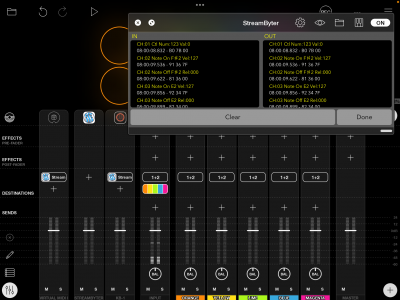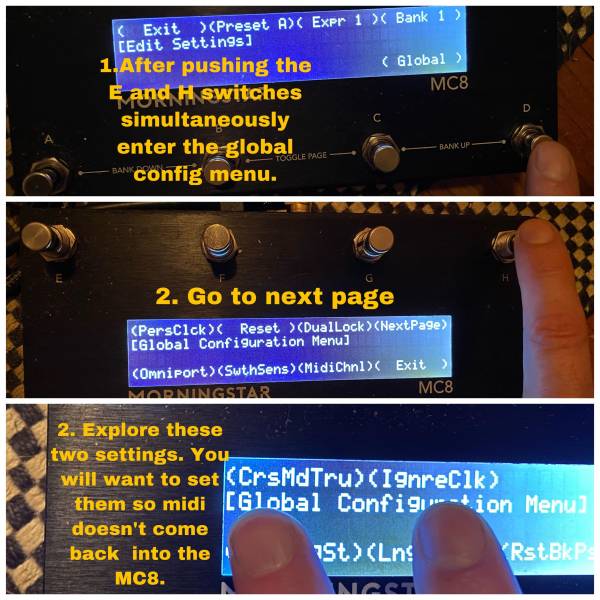This is an old revision of the document!
Loopy Pro: Troubleshooting
This page covers tips for troubleshooting Loopy Pro. If you have not checked Loopy Pro's manual, you may want to start by taking a look at the Loopy Pro Manual a link to it is found in Loopy Pro's Help menu.
Audio Levels Of Recorded Tracks Seems Too Loud
If you are running Loopy Standalone and using your device's built-in mic and tracks play back much louder than you expect, take a look at the Echo Cancellation settings. Echo cancellation is a handy feature for using the built-in mic and speakers without wearing headphones. It has the side effect of boosting the gain to account for a bug in Apple's Measurement Mode which is used for Echo Cancellation.
To turn off Echo Cancellation, tap on the mic icon in the mixer to see the input options and turn off Echo Cancellation. If you don't plan on using the mic, you might even want to delete that channel from the mixer.
Using a MIDI Monitor to Examine MIDI
It is sometimes useful to be able to see the MIDI coming in from controllers or that is being sent from between plugins or widgets. A MIDI Monitoring AUv3 is very handy. Some useful (and free) MIDI Monitor AUv3 are:
- Show MIDI - ShowMIDI is a non-logging style MIDI monitor that shows current activity. Because it doesn't log data, it let's you focus on what is happening know without having to wade through a large list of messages. You may also want a logging style MIDI monitor (all the others below are logging style) plug-in.
- Streambyter - Streambyter is a free iOS MIDI-processing plugin that also has a MIDI monitor built-in. As a MIDI processor Streambyter might be intimidating, but the MIDI Monitor works well and can be used without knowing about StreamByter.
- mfxMonitor is a free MIDI monitor from Streambyter's developer
- MIDI Tools includes a MIDI Monitor
To use the MIDI Monitor:
- Display Loopy Pro's Mixer in extended view
- Tap the + sign to add a mixer channel
- Choose Add MIDI
- Choose the MIDI Monitor
- Choose Add MIDI to add your source device or Virtual MIDI (to spy on the traffic coming into Loopy Pro's virtual MIDI port)
- Tap on the + sign in the Destination cell for the device you want to monitor and choose the MIDI Monitor you used earlier.
Open the MIDI Monitor's window and you can watch the MIDI traffic.
Streambyter Note. If you are new to Streambyter, tap on the button with the magnifying glass icon to see its MIDI monitor.
Quick tutorial showing StreamByter as a MIDI Monitor in Loopy:
MIDI Pedal/Controller Troubleshooting
If you get surprising response when controlling Loopy via MIDI, there are a few things to check.
The first thing to check if things seem really strange is if turning Loopy's feedback to controllers solves the problem. Some of these problems seem connected to messages that Loopy sends out (possibly to update status LEDs). In the MIDI Control panel, find your MIDI controller in the list of MIDI sources at the top of the MIDI Control window and display Loopy's settings. Turn off the setting labeled Feedback Enabled and see if that solves things.
If that does not solve your problem, you may want to see if your pedal has a setting to ignore incoming MIDI in case something else is sending MIDI back to your device.
What is your pedal sending? The Loopy Pro's MIDI Learn assumes that a pedal sends a value when pressed and another value when released. If your pedal does not send a CC value of 127 (or note velocity of 127) when pressed and 0 when released, it may throw off what Loopy Pro thinks you are trying to do. Loopy Pro allows you to specify the correct trigger if it makes the wrong guess about what the trigger is. You may want to use a MIDI Monitor to see what your pedal is sending. Using a MIDI Monitor is covered elsewhere on this page.
For the Morningstar pedals, use the pedal's global configuration menu to turn Cross MIDI Thru Off and Ignore MIDI Clock On.
Here's a helpful video for the Morningstar pedal from John Paul Music UK
MIDI Controlled Effects Not Responding
If you have an AUv3 such as a sampler that responds to MIDI and which is not responding, you may need to turn off idling for that effect. Normally, Loopy puts effects that aren't receiving any audio input to sleep in order to free up CPU. This is called idling. To turn off idling, open the AUv3 window. Long-press on the label that says On, Off, or Idle and turn off Enable Idle Mode in the panel that pops up.

